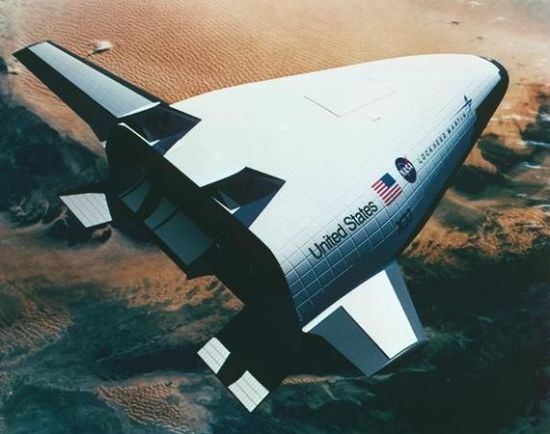|
||||||||||
|
|
||||||||||
|
||||||||||
|
|
||||||||||
 - -
|
|

|
Lockheed Martin X-33 Reusable Launch Vehicle Prototype |
|
DESCRIPTION:
With the cost of space flight still hovering at around $10,000 per pound, NASA spearheaded the development of a number of potentially revolutionary technology demonstration projects. The purpose of these efforts was to reduce the cost of lifting a pound into orbit to as little as $1,000. The most significant project under the umbrella of the Space Launch Initiative (SLI) was the Lockheed Martin X-33 announced in 1996. The ultimate goal of the X-33 was to develop a completely reusable single-stage-to-orbit (SSTO) launch vehicle to replace the aging Space Shuttle by about 2010. Although both McDonnell Douglas and Rockwell competed for the X-33 contract, Lockheed's lifting-body wedge shape incorporating a number of advanced features was judged the most promising. Among the critical new technologies Lockheed planned to develop to make SSTO possible were very strong and lightweight composite fuel tanks, an integrated thermal protection system to make the heat-absorbing tiles used on the Space Shuttle unnecessary, automated flight control systems, and linear aerospike engines believed to be more efficient than standard rocket engines (find out more at the Aerospaceweb.org Aerospike Engine site). Most importantly, the X-33 needed to demonstrate levels of serviceability, rapid turn-around time between flights, and low-cost maintenance as yet unseen in launch vehicles. If the X-33 technology demonstrator proved successful, NASA and Lockheed Martin hoped to develop a full-sized vehicle twice the size of the X-33 called the VentureStar that would supersede the Space Shuttle as America's primary launch platform. The ambitious project set in motion a rapid test program with the first flight set for early 1999. Unfortunately, these goals proved too ambitious since the X-33 was beset by a number of difficult and time-consuming technical problems. Early wind tunnel and flight tests of X-33 models proved the wedge shape to be longitudinally unstable requiring changes to the control surfaces. In addition, the aerospike engine suffered development delays, as did the thermal protection system. Most critical, however, was the failure of the composite fuel tanks that eventually forced Lockheed Martin to abandon them altogether. Aluminum tanks were instead substituted, but the change forced modifications to the vehicle structure and increased overall weight. Individually, each of these difficulties was probably not fatal, but together they convinced NASA that the X-33 relied on too many untried and unproven technologies that could not be developed for as low a cost and with as great a reliability as the X-33 performance requirements demanded. As a result, NASA cancelled further spending on the X-33 in March 2001 after the vehicle was about 75% complete. Lockheed Martin had already invested over $200 million of company funds in the project, and NASA's cancellation left the firm free to complete and fly the X-33 alone. Lockheed elected not to do so, however, and the VentureStar program appears to have been permanently shelved. Nevertheless, Congressional supporters of the X-33 argued for a renewal of the project as a US Air Force program, but this idea too has never progressed any further.
Data below estimated for X-33 |
|
| HISTORY: | |
| First Flight |
never flown
|
| CREW: |
none
|
|
ESTIMATED COST:
|
unknown
|
| AIRFOIL SECTIONS: | |
| Wing Root | unknown |
|
Wing Tip
|
unknown
|
| DIMENSIONS: | |
| Length |
(X-33) 69.00 ft (21.05 m) (VentureStar) 127.00 ft (38.75 m) |
| Wingspan | 68 ft (20.74 m) |
| Height | 22.17 ft (6.76 m) |
| Wing Area | 2,125 ft² (198 m²) |
|
Canard Area
|
not applicable
|
| WEIGHTS: | |
| Empty | 62,700 lb (28,440 kg) |
| Normal Takeoff | unknown |
| Max Takeoff |
(X-33) 273,300 lb (123,965 kg) (VentureStar) 2,186,000 lb (991,550 lb) |
| Fuel Capacity |
30,000 lb (13,605 kg) liquid oxygen 180,000 lb (81,645 kg) liquid hydrogen 210,000 lb (95,255 kg) total |
|
Max Payload
|
unknown
|
| PROPULSION: | |
| Powerplant |
(X-33) two XRS-2200 linear aerospike rocket engines (VentureStar) seven RS-2200 linear aerospike rocket engines |
| Thrust |
(X-33) 410,000 lb (1,823 kN) at sea level (X-33) 536,000 lb (2,384 kN) in vacuum (VentureStar) 3,017,000 lb (13,420 kN) at sea level (VentureStar) 3,465,000 lb (15,414 kN) in vacuum |
| PERFORMANCE: | |
| Max Level Speed |
at altitude: 11,000 mph (17,690 km/h), Mach 15 at sea level: not applicable |
| Initial Climb Rate | unknown |
| Service Ceiling |
(X-33) 250,000 ft (76,270 m) (VentureStar) orbital |
| Range | 825 nm (1,530 km) |
| g-Limits |
unknown
|
| KNOWN VARIANTS: | |
| X-33 | 53%-scale flight demonstrator of the full-sized vehicle that was to be powered to Mach 15 by two prototype linear aerospike engines, vehicle was to be capable of suborbital flights up to an altitude of about 50 miles; 1 under construction but cancelled when about 75% complete |
| VentureStar |
Proposed full-scale reusable launch vehicle propelled into orbit by seven linear aerospike engines; not
built
|
|
KNOWN OPERATORS:
|
none
|
|
3-VIEW SCHEMATIC:

|
|
SOURCES:
|
|


|
Aircraft | Design | Ask Us | Shop | Search |

|
|
| About Us | Contact Us | Copyright © 1997- | |||
|
|
|||